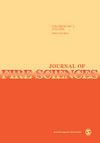Improvement of heat release methodologies using mass loss calorimeter and oxygen consumption hood to assess flammability of wood plastic composites
IF 1.9
4区 工程技术
Q2 ENGINEERING, MULTIDISCIPLINARY
引用次数: 0
Abstract
The mass loss calorimeter provides a robust method for evaluating flammability of very sooty materials such as wood plastic composites as a lower cost and rugged alternative to the reliable and effective cone calorimeter. The high amounts of smoke and carbon monoxide associated with these materials resulted in a much-reduced heat release rate, resulting in incomplete combustion of the diffusion flame, which required modifications to the standards in measuring heat release rate via oxygen consumption or carbon dioxide production or thermopiles. In addition to liquid fuels of ethylene glycol and methanol, the solids polystyrene and polymethyl methacrylate were used as calibration materials for the mass loss calorimeter and the instrumented heat release rate hood. Because of concerns about the flue gas thermopile methodology for heat release rate measurements, a second thermopile was attached to the exterior of the metal pipe chimney typically used for heat release rate calculations in the mass loss calorimeter. A heat balance analysis indicated that this is an effective design compared with alternative designs. Estimates of flaming heat release rate are reported using both signals from the thermopiles for calculation of heat release rates and confirmed with the updated oxygen consumption analysis under an instrumented hood. This special fire test arrangement was used to assess the flammability of four different wood plastic composites, some with fire-retardant treatments, such as ammonium polyphosphate and brominated, all of which tended to have high smoke production leading to high-radiant energy losses. The reduction of heat release rate with 10% by content of fire-retardant treatment was confirmed by both heat release rate measures. The average heat release rate decreased 19% to 39% when fire retardants were added, relative to this wood flour–polyethylene composite.利用质量损失热量计和耗氧罩改进热释放方法,以评估木塑复合材料的可燃性
质量损失热量计为评估木塑复合材料等烟尘量非常大的材料的可燃性提供了一种可靠的方法,是可靠有效的锥形热量计的一种成本较低、坚固耐用的替代方法。与这些材料相关的大量烟雾和一氧化碳导致热释放率大大降低,造成扩散火焰不完全燃烧,因此需要修改通过氧气消耗或二氧化碳产生或热电堆测量热释放率的标准。除了乙二醇和甲醇等液体燃料外,固体聚苯乙烯和聚甲基丙烯酸甲酯也被用作质量损失热量计和仪器热释放率罩的校准材料。由于烟道气体热电堆测量热释放率的方法令人担忧,因此在通常用于计算质量损失热量计热释放率的金属管烟囱外部安装了第二个热电堆。热平衡分析表明,与其他设计相比,这是一种有效的设计。报告中对火焰热释放率的估计既使用了热电堆的信号来计算热释放率,也使用了仪器罩下的最新耗氧量分析来确认。这种特殊的防火试验安排用于评估四种不同木塑复合材料的可燃性,其中一些复合材料经过阻燃处理,如多磷酸铵和溴化处理,所有这些复合材料都倾向于产生大量烟雾,导致高辐射能损失。两种热释放率测量方法都证实,阻燃处理含量达到 10%时,热释放率会降低。与这种木粉-聚乙烯复合材料相比,添加阻燃剂后,平均热释放率降低了 19% 至 39%。
本文章由计算机程序翻译,如有差异,请以英文原文为准。
求助全文
约1分钟内获得全文
求助全文
来源期刊

Journal of Fire Sciences
工程技术-材料科学:综合
CiteScore
4.00
自引率
0.00%
发文量
14
审稿时长
2.5 months
期刊介绍:
The Journal of Fire Sciences is a leading journal for the reporting of significant fundamental and applied research that brings understanding of fire chemistry and fire physics to fire safety. Its content is aimed toward the prevention and mitigation of the adverse effects of fires involving combustible materials, as well as development of new tools to better address fire safety needs. The Journal of Fire Sciences covers experimental or theoretical studies of fire initiation and growth, flame retardant chemistry, fire physics relative to material behavior, fire containment, fire threat to people and the environment and fire safety engineering. This journal is a member of the Committee on Publication Ethics (COPE).
 求助内容:
求助内容: 应助结果提醒方式:
应助结果提醒方式:


